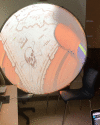Virtual reality environment using a dome screen for procedural pain in young children during intravenous placement: A pilot randomized controlled trial
- PMID: 34464411
- PMCID: PMC8407539
- DOI: 10.1371/journal.pone.0256489
Virtual reality environment using a dome screen for procedural pain in young children during intravenous placement: A pilot randomized controlled trial
Abstract
We assessed the feasibility and potential efficacy of a virtual reality (VR) environment using a dome screen as a distraction method in young children during intravenous (IV) placement in the pediatric emergency department. This randomized controlled pilot study enrolled children aged 2 to 6 years who underwent IV placement into either the intervention group or the control group. Children in the intervention group experienced VR using a dome screen during IV placement. The child's pain intensity was measured using the Face, Legs, Activity, Cry, and Consolability (FLACC) scale at four time points of IV placement: immediately after arrival to the blood collection room (base); immediately after the child laid down on the bed (preparation); when the tourniquet was applied (tourniquet); and the moment at which the needle penetrated the skin (venipuncture). The guardian's satisfaction and rating of the child's distress were assessed using a 5-point Likert-type questionnaire. We recruited 19 children (9 in the intervention group and 10 in the control group). Five children in the control group were excluded from the analysis because of missing video recordings (n = 3), failed first attempt at IV placement (n = 1), and the child's refusal to lie on the bed during the procedure (n = 1). No side effects of VR were reported during the study period. Although the average FLACC scale score at each time point (preparation, tourniquet, venipuncture) was lower in the intervention group than the control group, the difference was not statistically significant (2.3, interquartile range [IQR]: 2.0-3.0; vs. 3.3, IQR: 2.7-6.7, P = 0.255). There were no statistically significant differences between the groups in the guardian's satisfaction and anxiety or his/her rating of the child's pain and anxiety. The guardians and emergency medical technicians reported satisfaction with the use of VR with a dome screen and considered it a useful distraction during the procedure. VR using a dome screen is a feasible distraction method for young children during IV placement. A larger clinical trial with further development of the VR environment and study process is required to adequately evaluate the efficacy of VR using a dome screen.
Conflict of interest statement
The authors have declared that no competing interests exist.
Figures
References
-
- Eldridge C, Kennedy R. Nonpharmacologic techniques for distress reduction during emergency medical care: a review. Clinical Pediatric Emergency Medicine. 2010;11(4):244–50.
Publication types
MeSH terms
LinkOut - more resources
Full Text Sources
Medical




